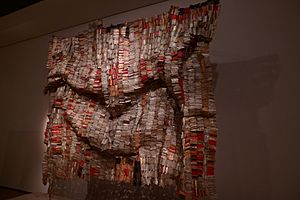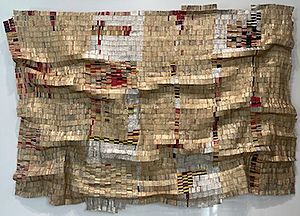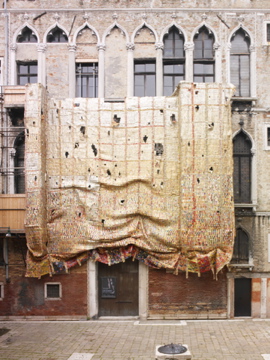El Anatsui facts for kids
Quick facts for kids
El Anatsui
|
|
|---|---|
| Born | 4 February 1944 Anyako, Volta Region, Ghana
|
| Nationality | Ghanaian |
| Alma mater | Kwame Nkrumah University of Science and Technology |
| Known for | Visual Art, Sculpture |
| Awards | Prince Claus Award |
El Anatsui (born February 4, 1944) is a famous Ghanaian sculptor. He has spent most of his career creating art in Nigeria. He is especially known around the world for his amazing "bottle-top installations."
These artworks are made from thousands of aluminum pieces. These pieces come from places where alcohol bottles are recycled. He sews them together with copper wire. This turns them into metallic, cloth-like sculptures that hang on walls. Even though the materials seem stiff, they are actually flexible. This makes them easy to move and arrange when he installs his art.
El Anatsui was recognized in the 2023 Time 100 list. This list features the world's most influential people.
Contents
Early Life and Education
El Anatsui was born in Anyako, a town in the Volta Region of Ghana. He was the youngest of his father's 32 children. He lost his mother and was raised by his uncle.
His first experience with art was drawing letters on a chalkboard. His school's headmaster noticed his drawings. The headmaster encouraged him by giving him more chalk. El Anatsui was very young then, just after kindergarten. He saw the letters more as interesting shapes than as actual letters.
University Studies
Anatsui earned his first degree in 1968 from the College of Art and Built Environment (KNUST) in Kumasi, Ghana. He then received a special diploma in Art Education in 1969. This was from Kwame Nkrumah University of Science and Technology (KNUST), also in Kumasi.
Some of his early art teachers included Oku Ampofo, Vincent Akwete Kofi, and Kofi Antubam. These artists started to use more local African art styles instead of foreign ones. After graduating in 1969, Anatsui became a teacher at Winneba Specialist Training College. This school is now called the University of Education, Winneba.
In 1975, he started teaching at the University of Nigeria, Nsukka. He became a senior lecturer in the Fine and Applied Arts department in 1982. Later, in 1996, he became the head of that department and a full professor of sculpture. He held this important role until 2011. His time at the University of Nsukka connected him with a group of artists called the Nsukka group.
One art expert said that it took many years to find artists who could become famous globally. These artists chose to live outside big city art centers. For example, William Kentridge became well-known from Johannesburg. El Anatsui became famous worldwide while living and working in the Nigerian university town of Nsukka.
Amazing Artwork
Anatsui noticed that much of his art education focused on Western styles. He felt something was missing because it didn't focus enough on his own culture. To fix this, he started visiting the National Cultural Centre of Ghana in Kumasi. There, he met musicians, graphic artists, textile artists, and other creative people.
It was there that he discovered Adinkra symbols. These are a system of signs and symbols from Ghana. This was his first look at abstract art. It opened up a whole new world of artistic ideas for him.
Early Materials: Wood and Clay
In the 1970s, Anatsui often worked with wood. He was very interested in wooden trays. He saw these trays used in markets to display food and other items. He would carve or engrave them with Adinkra symbols and other designs. He used hot rods to make these marks.
He also started making wall panels from strips of wood placed side by side. He decorated the surface by using chainsaws, carving tools, fire, or paint. In the late 1970s, he began working with clay, especially pots. He explored ideas of how things can be fragile and break down. He was interested in how a broken pot, even if it can't hold food or water anymore, can still find new uses. He found it fascinating how broken pot pieces are used for spiritual offerings. He said it's like the broken pot becomes special for ancestors and spirits.
After working with broken pots, Anatsui explored food-related themes using other materials. He used wood again, in the form of mortars (bowls for grinding). He also used equipment for processing cassava and, of course, bottle tops.
Bottle Cap Masterpieces
Much of Anatsui's art uses "found materials." These are materials that were used for something else before he turned them into art. He focuses on the history of these materials. He likes how they show signs of human touch and use. He believes that when something has been used, it carries a special energy from the people who touched it. This helps guide his art and connects it to the culture around him.
Metal bottle caps are one of his favorite materials. Anatsui says that an arrangement of bottle caps is like cloth. It's flexible. This allows him to think about his art in two ways: as a sculpture (because of the cap shapes) and as a painting (because of the cap colors). He also likes that bottle caps show a glimpse into current and past social issues. This is because of the names and colors of different drink brands printed on them.
He explained that the most important thing for him is the change. These bottle caps, which once identified a drink, are now used for something new. They can make people think or wonder. This happens because they are taken from their usual use and put into a new art setting. They bring their own histories and identities with them.
Themes in His Art
Anatsui's work explores several important ideas:
- Transformation: How materials are broken down and then put back together. This is like a metaphor for life and the changes Africa went through during and after colonialism.
- Tradition: He uses traditional patterns and ideas from West African woven cloth and other African textiles.
- History: He is concerned about how Western scholars sometimes misunderstand African history.
- Culture and Consumption: His art is also connected to West African culture and ideas about what people buy and how they work.
The idea of Sankofa is also important in Anatsui's art. Sankofa means "go back and retrieve." He sees it as a way to learn from the past to help move forward. For him, Sankofa meant using what was around him. Ghana became independent when he was in high school. Much of his education focused on Western art. So, he felt he needed to "go back and retrieve" parts of Ghanaian culture that had been ignored. He called this a "quest for self-discovery."
Exhibitions Around the World

Anatsui's art career grew steadily. It started in his home area of Nsukka and then spread to cities like Enugu and Lagos. Eventually, his work became known internationally. In 1990, Anatsui had his first important group show. It was at the Studio Museum in Harlem in Harlem, New York. He was also one of three artists highlighted in a 1990 exhibition called "Contemporary African Artists: Changing Traditions." This show was so popular it was extended for five years.
Since then, Anatsui has shown his art all over the world. His work has been displayed at famous places like the Brooklyn Museum (2013), the Metropolitan Museum of Art in New York (2008–09), and the National Museum of African Art in Washington, D.C. (2008). He also participated in the Venice Biennale in 1990 and 2007.
In 1995, Anatsui had his first solo exhibition outside of Africa, in London. He showed many different themes. He proved that African art can be displayed in many ways, not just what people might expect. His work used ideas common in European and American art, which was new for African countries.
Anatsui's work was shown at the de Young Museum in San Francisco in 2005. This was the first time his art became part of the permanent collection in a major art museum. Also in 2005, his exhibition "Danudo" at New York's Skoto Gallery was the first time his metal sheet artworks were shown in an American city. This exhibition helped make his bottle-cap works very popular.
Anatsui was invited to the Venice Biennale in 2006 and again in 2007. For the 2007 event, he was asked to create two large hanging metal tapestries. He displayed his works at the Palazzo Fortuny. These included three new metal hangings called Dusasa. Each artwork had different textures and colors, like golds, reds, and blacks. The way the bottle tops draped made the pieces look soft and gentle.

A large exhibition of his recent works, called Gravity & Grace: Monumental Works by El Anatsui, opened in New York at the Brooklyn Museum in 2013. This exhibition later traveled to other museums in the United States.
A big show covering his entire career, called Triumphant Scale, opened in March 2019 at Munich's Haus der Kunst. It attracted record numbers of visitors. From there, the show traveled to the Arab Museum of Modern Art in Doha and then to the Kunstmuseum Bern in 2020.
Anatsui was chosen for the 2023 Hyundai Commission at the Turbine Hall at Tate Modern. This is a huge space for very large sculptures. His artwork, "Behind the Red Moon," is made of thousands of metal bottle tops and pieces. It builds on his work with materials linked to the transatlantic slave trade. This artwork was on display until April 14, 2024.
Other Activities
In 1992, Anatsui was chosen to be a member of the International Society for Education through Art (InSEA) world council. This was for his important work in education. In 2000, Anatsui helped start the Forum for African Arts. That same year, he also became a member of the International Selection Committee for the Dakar Biennale in Senegal. In 2001, he was a fellow at the Civitella Ranieri Foundation in Italy.
Awards and Recognition
Anatsui has received many awards for his art:
- In 1968, as a university student, he won an honorable mention at the First Ghana National Art Competition.
- The next year, in 1969, he was named Best Student of the Year at the College of Art in Kumasi, Ghana.
- In 1983, he was asked to create two large public sculptures for the Nsukka campus.
- In 1984, he was one of ten artists invited to a special art residency in Cuxhaven, West Germany.
In 1990, Anatsui was invited to the 44th annual Venice Biennale show, "5 Contemporary African Artists." He received an honorable mention there. That year, he was also featured in an American documentary called Nigerian Art-Kindred Spirits.
In 2015, the Venice Biennale gave Anatsui the Golden Lion for Lifetime Achievement. This is a very high honor. In 2017, Anatsui received the Praemium Imperiale. He was the first Ghanaian artist to win this international art prize.
Other awards include:
- 1990 – Public Prize, 7th Annual Triennale der Kleinplastik
- 1995 – Kansai Telecasting Prize, 6th Osaka Sculpture Triennial
- 1998 – Bronze Prize, 9th Osaka Sculpture Triennial
- 2008 – Visionaries! Award, Museum of Arts and Design (MAD)
- 2009 – Prince Claus Award
- 2009 – Artist Honoree, 30th Anniversary Celebration, National Museum of African Art
- 2016 – Honorary doctorate, Harvard University
- 2017 – Honorary doctorate, Kwame Nkrumah University of Science and Technology
- 2023 – Time 100
- 2024 – Honorary Doctor of Fine Arts, Bard College
See also
 In Spanish: El Anatsui para niños
In Spanish: El Anatsui para niños


